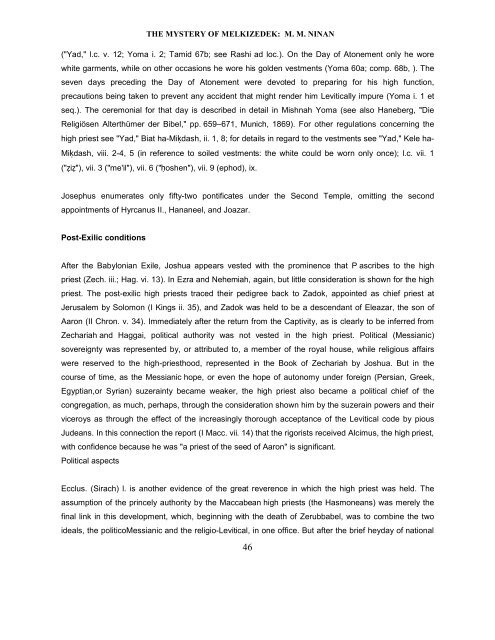Mystery of Melchzedek
Create successful ePaper yourself
Turn your PDF publications into a flip-book with our unique Google optimized e-Paper software.
THE MYSTERY OF MELKIZEDEK: M. M. NINAN<br />
("Yad," l.c. v. 12; Yoma i. 2; Tamid 67b; see Rashi ad loc.). On the Day <strong>of</strong> Atonement only he wore<br />
white garments, while on other occasions he wore his golden vestments (Yoma 60a; comp. 68b, ). The<br />
seven days preceding the Day <strong>of</strong> Atonement were devoted to preparing for his high function,<br />
precautions being taken to prevent any accident that might render him Levitically impure (Yoma i. 1 et<br />
seq.). The ceremonial for that day is described in detail in Mishnah Yoma (see also Haneberg, "Die<br />
Religiösen Alterthümer der Bibel," pp. 659–671, Munich, 1869). For other regulations concerning the<br />
high priest see "Yad," Biat ha-Miḳdash, ii. 1, 8; for details in regard to the vestments see "Yad," Kele ha-<br />
Miḳdash, viii. 2-4, 5 (in reference to soiled vestments: the white could be worn only once); l.c. vii. 1<br />
("ẓiẓ"), vii. 3 ("me'il"), vii. 6 ("ḥoshen"), vii. 9 (ephod), ix.<br />
Josephus enumerates only fifty-two pontificates under the Second Temple, omitting the second<br />
appointments <strong>of</strong> Hyrcanus II., Hananeel, and Joazar.<br />
Post-Exilic conditions<br />
After the Babylonian Exile, Joshua appears vested with the prominence that P ascribes to the high<br />
priest (Zech. iii.; Hag. vi. 13). In Ezra and Nehemiah, again, but little consideration is shown for the high<br />
priest. The post-exilic high priests traced their pedigree back to Zadok, appointed as chief priest at<br />
Jerusalem by Solomon (I Kings ii. 35), and Zadok was held to be a descendant <strong>of</strong> Eleazar, the son <strong>of</strong><br />
Aaron (II Chron. v. 34). Immediately after the return from the Captivity, as is clearly to be inferred from<br />
Zechariah and Haggai, political authority was not vested in the high priest. Political (Messianic)<br />
sovereignty was represented by, or attributed to, a member <strong>of</strong> the royal house, while religious affairs<br />
were reserved to the high-priesthood, represented in the Book <strong>of</strong> Zechariah by Joshua. But in the<br />
course <strong>of</strong> time, as the Messianic hope, or even the hope <strong>of</strong> autonomy under foreign (Persian, Greek,<br />
Egyptian,or Syrian) suzerainty became weaker, the high priest also became a political chief <strong>of</strong> the<br />
congregation, as much, perhaps, through the consideration shown him by the suzerain powers and their<br />
viceroys as through the effect <strong>of</strong> the increasingly thorough acceptance <strong>of</strong> the Levitical code by pious<br />
Judeans. In this connection the report (I Macc. vii. 14) that the rigorists received Alcimus, the high priest,<br />
with confidence because he was "a priest <strong>of</strong> the seed <strong>of</strong> Aaron" is significant.<br />
Political aspects<br />
Ecclus. (Sirach) l. is another evidence <strong>of</strong> the great reverence in which the high priest was held. The<br />
assumption <strong>of</strong> the princely authority by the Maccabean high priests (the Hasmoneans) was merely the<br />
final link in this development, which, beginning with the death <strong>of</strong> Zerubbabel, was to combine the two<br />
ideals, the politicoMessianic and the religio-Levitical, in one <strong>of</strong>fice. But after the brief heyday <strong>of</strong> national<br />
46


















